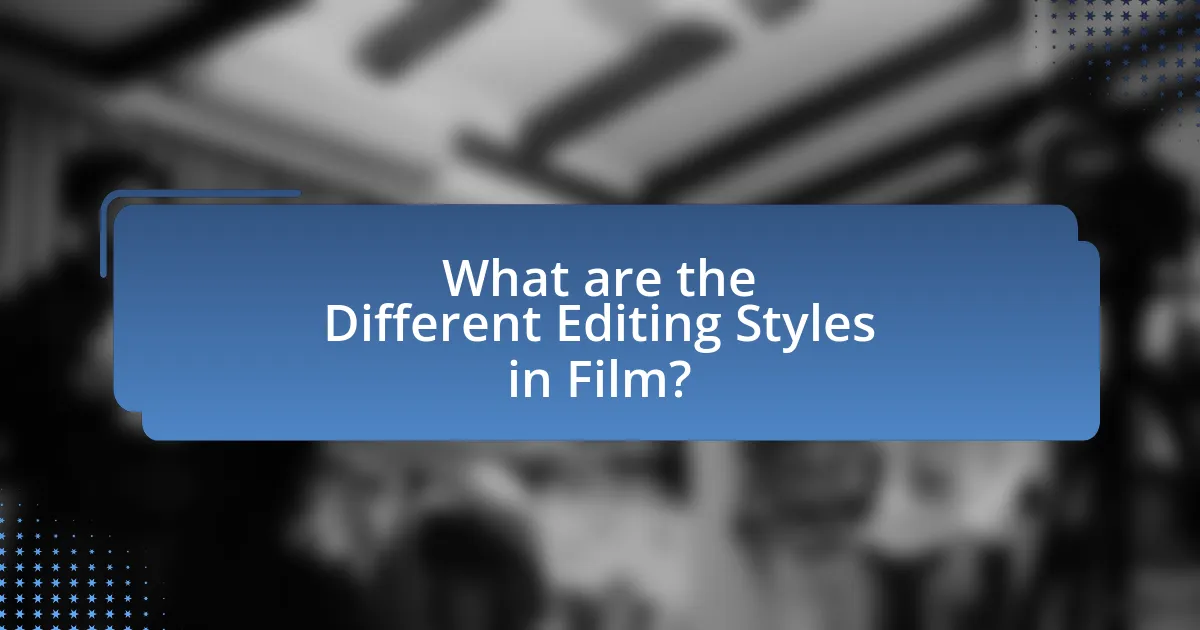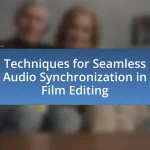The Art of Cutting in Film encompasses the techniques of editing that shape a film’s narrative and emotional impact through the selection and arrangement of shots. This article explores how editing influences storytelling, including key elements such as continuity, pacing, and transitions, and examines various editing styles like continuity editing, montage, and jump cuts. It highlights the significance of pacing in audience engagement, the role of editing in character development, and the impact of different styles across genres. Additionally, the article discusses the tools and software used in film editing, best practices for effective editing, and how editors can develop their unique styles.

What is the Art of Cutting in Film?
The Art of Cutting in Film refers to the technique of editing that involves selecting and arranging shots to create a coherent narrative and emotional impact. This process is crucial in shaping the pacing, rhythm, and overall storytelling of a film. Effective cutting can enhance the viewer’s experience by creating tension, emphasizing character development, and guiding the audience’s attention. Historical examples, such as the rapid cuts in Sergei Eisenstein’s “Battleship Potemkin,” demonstrate how cutting can evoke strong emotional responses and convey complex ideas through visual storytelling.
How does editing influence the storytelling process in film?
Editing significantly influences the storytelling process in film by shaping the narrative structure, pacing, and emotional impact. Through techniques such as cuts, transitions, and sequencing, editors control how scenes are presented, which directly affects audience perception and engagement. For instance, the use of montage can condense time and convey complex ideas quickly, as seen in films like “Rocky,” where training sequences are edited to create a sense of progression and urgency. Additionally, editing can manipulate the rhythm of a film, enhancing tension or providing relief, thereby guiding the viewer’s emotional journey. The impact of editing is evident in the way it can alter the meaning of a scene; for example, the juxtaposition of contrasting shots can create irony or highlight thematic elements, as demonstrated in “The Godfather,” where the baptism scene intercuts with violent acts to underscore the duality of Michael Corleone’s character.
What are the key elements of film editing?
The key elements of film editing include continuity, pacing, transitions, and the use of cuts. Continuity ensures that the narrative flows logically and maintains spatial and temporal coherence, which is essential for audience understanding. Pacing involves the rhythm of the film, influencing how quickly or slowly scenes unfold, thereby affecting emotional engagement. Transitions, such as fades and wipes, help to signify changes in time or location, guiding the viewer through the story. The use of cuts, including jump cuts and match cuts, can create tension or emphasize connections between scenes. These elements collectively shape the viewer’s experience and interpretation of the film.
How does pacing affect audience engagement?
Pacing significantly affects audience engagement by controlling the rhythm and flow of a narrative, which influences viewers’ emotional responses and attention levels. When pacing is well-executed, it can create suspense, maintain interest, and enhance the overall storytelling experience. For instance, studies show that films with varied pacing, such as quick cuts during action sequences and slower moments for character development, keep audiences more engaged compared to films with a monotonous pace. Research by the University of Southern California found that films with dynamic pacing scored higher in audience retention and emotional impact, demonstrating that effective pacing is crucial for maximizing engagement.
Why is the choice of editing style important?
The choice of editing style is important because it significantly influences the narrative structure and emotional impact of a film. Different editing styles, such as continuity editing or montage, can shape how audiences perceive time, space, and character relationships. For instance, continuity editing maintains a seamless flow, enhancing viewer immersion, while montage can create emotional resonance by juxtaposing contrasting images. Studies, such as those by Bordwell and Thompson in “Film Art: An Introduction,” demonstrate that editing choices directly affect audience engagement and interpretation, underscoring the critical role of editing in storytelling.
What impact does editing style have on the film’s tone?
Editing style significantly impacts a film’s tone by shaping the pacing, rhythm, and emotional resonance of the narrative. For instance, rapid cuts can create a sense of urgency or chaos, often seen in action films, while longer takes can evoke contemplation and intimacy, as demonstrated in dramas. The choice of transitions, such as fades or wipes, also influences the viewer’s emotional response, reinforcing the film’s atmosphere. Studies have shown that editing techniques directly affect audience engagement and perception, highlighting the critical role of editing in establishing a film’s overall tone.
How can editing styles shape character development?
Editing styles can significantly shape character development by influencing how audiences perceive and connect with characters. For instance, rapid cuts can create a sense of urgency and chaos, reflecting a character’s internal turmoil, while longer takes can foster intimacy and allow viewers to engage more deeply with a character’s emotions. Research shows that editing techniques, such as continuity editing versus montage, can alter the narrative flow and character arcs, thereby affecting audience empathy and understanding. For example, in films like “Birdman,” the seamless editing style enhances the protagonist’s psychological state, making the audience feel his struggles more acutely. Thus, the choice of editing style directly impacts character portrayal and audience engagement.

What are the Different Editing Styles in Film?
The different editing styles in film include continuity editing, montage editing, jump cuts, cross-cutting, and match cuts. Continuity editing aims to create a seamless flow of action and maintain spatial and temporal coherence, often using techniques like the 180-degree rule. Montage editing juxtaposes disparate images to create meaning or evoke emotion, famously utilized by Sergei Eisenstein in films like “Battleship Potemkin.” Jump cuts disrupt the continuity to create a sense of urgency or disorientation, as seen in Jean-Luc Godard’s “Breathless.” Cross-cutting alternates between two or more scenes happening simultaneously, enhancing tension, exemplified in films like “The Godfather.” Match cuts connect two scenes through similar visual elements, creating a thematic link, as demonstrated in Stanley Kubrick’s “2001: A Space Odyssey.” Each style serves distinct narrative purposes and influences audience perception.
What are the most common editing styles used in filmmaking?
The most common editing styles used in filmmaking include continuity editing, montage editing, and jump cuts. Continuity editing aims to create a seamless flow of action, ensuring that the narrative is coherent and easy to follow, which is essential for audience engagement. Montage editing, on the other hand, juxtaposes various images and scenes to convey a specific theme or emotion, often compressing time and space to enhance storytelling. Jump cuts disrupt the flow of time and space, creating a jarring effect that can emphasize a character’s emotional state or highlight a significant moment. These styles are foundational in film, shaping how stories are told and experienced by viewers.
How does continuity editing maintain narrative flow?
Continuity editing maintains narrative flow by ensuring that the visual and auditory elements of a film are consistent and coherent, allowing the audience to follow the story seamlessly. This technique involves matching action, screen direction, and spatial relationships between shots, which helps to create a logical progression of events. For instance, the 180-degree rule is a fundamental principle in continuity editing that preserves the spatial relationship between characters, preventing disorientation. By adhering to these conventions, filmmakers can guide viewers through the narrative without confusion, thereby enhancing engagement and comprehension.
What is the role of montage in storytelling?
Montage plays a crucial role in storytelling by condensing time and enhancing narrative through the juxtaposition of images. This editing technique allows filmmakers to convey complex ideas, emotions, and themes efficiently, often creating a rhythm that propels the story forward. For instance, in Sergei Eisenstein’s film “Battleship Potemkin,” the famous Odessa Steps sequence utilizes montage to evoke intense emotional responses and highlight the chaos of revolution, demonstrating how rapid cuts can amplify tension and meaning. Thus, montage not only serves to advance the plot but also enriches the viewer’s experience by creating connections between disparate scenes.
How do editing styles vary across different genres?
Editing styles vary significantly across different genres, as each genre employs unique techniques to enhance storytelling and evoke specific emotional responses. For instance, action films often utilize rapid cuts and dynamic pacing to create excitement and tension, while dramas may favor longer takes and slower transitions to allow for character development and emotional depth. In horror films, editing techniques such as jump cuts and abrupt transitions are frequently used to build suspense and surprise the audience. Documentaries typically employ a more straightforward editing style, focusing on continuity and clarity to present factual information effectively. These variations in editing styles are essential for aligning the visual narrative with the genre’s thematic elements and audience expectations.
What editing techniques are prevalent in action films?
Action films commonly utilize rapid cuts, cross-cutting, and montage editing techniques. Rapid cuts create a sense of urgency and excitement, often seen in fight scenes or chase sequences, where the quick succession of shots heightens tension. Cross-cutting, or parallel editing, allows simultaneous action to unfold in different locations, enhancing the narrative’s pace and intensity. Montage editing condenses time and space, effectively conveying a character’s training or preparation through a series of brief, impactful shots. These techniques are essential in maintaining the fast-paced rhythm characteristic of action films, as evidenced by their frequent use in successful franchises like “The Bourne Identity” and “Mad Max: Fury Road.”
How does editing differ in documentaries compared to fiction films?
Editing in documentaries differs from fiction films primarily in its approach to narrative structure and the use of real footage. Documentaries often rely on a more linear and factual presentation, emphasizing authenticity and the actual events captured, while fiction films utilize editing to create dramatic tension, pacing, and character development through scripted scenes. For instance, documentary editing may involve assembling interviews and observational footage to convey a specific message or theme, whereas fiction film editing focuses on crafting a cohesive story arc, often employing techniques like montage and cross-cutting to enhance emotional impact. This distinction is evident in the editing styles of notable works, such as the documentary “13th,” which uses archival footage and interviews to present a historical argument, contrasting with the narrative-driven editing found in films like “Inception,” where editing shapes the viewer’s experience of a complex storyline.

How do Editors Choose Their Techniques?
Editors choose their techniques based on the narrative requirements of the film, the emotional tone they wish to convey, and the pacing needed for the story. They analyze the script and footage to determine which editing style—such as continuity editing, montage, or jump cuts—best serves the film’s objectives. For instance, continuity editing is often employed to maintain a seamless flow of action, while montage can be used to compress time or convey complex ideas quickly. The choice of technique is also influenced by the genre of the film; for example, horror films may utilize abrupt cuts to create tension. Additionally, editors often draw from established practices within the industry, informed by historical trends and audience expectations, to enhance storytelling effectiveness.
What factors influence an editor’s choice of style?
An editor’s choice of style is influenced by narrative structure, audience expectations, and the emotional tone of the film. Narrative structure dictates how the story unfolds, guiding the pacing and rhythm of edits to enhance storytelling. Audience expectations shape style choices based on genre conventions; for instance, a horror film may employ quick cuts to build tension, while a romantic drama might favor longer takes for emotional depth. Additionally, the emotional tone of the film informs stylistic decisions, as editors select techniques that evoke specific feelings, such as using soft transitions for nostalgia or abrupt cuts for shock. These factors collectively ensure that the editing style aligns with the film’s overall vision and impact.
How does the director’s vision shape editing decisions?
The director’s vision fundamentally shapes editing decisions by guiding the narrative flow, pacing, and emotional impact of a film. This vision influences how scenes are cut together, determining which shots are prioritized to convey the intended story and mood. For instance, a director aiming for a fast-paced thriller will favor quick cuts and dynamic transitions, while a director focused on a contemplative drama may opt for longer takes and slower edits to enhance emotional depth. This alignment between the director’s artistic intent and the editing process ensures that the final product resonates with the audience as envisioned.
What role does audience expectation play in editing choices?
Audience expectation significantly influences editing choices by guiding the pacing, structure, and emotional impact of a film. Editors consider what audiences anticipate in terms of narrative flow and visual style to create a cohesive viewing experience. For instance, a suspenseful thriller may employ rapid cuts to heighten tension, aligning with audience expectations for excitement and urgency. Conversely, a romantic drama might utilize longer takes to foster emotional connection, reflecting audience desires for intimacy and reflection. This alignment with audience expectations is supported by research indicating that viewers often have preconceived notions about genre conventions, which editors leverage to enhance engagement and satisfaction.
What tools and software are commonly used in film editing?
Commonly used tools and software in film editing include Adobe Premiere Pro, Final Cut Pro, Avid Media Composer, and DaVinci Resolve. Adobe Premiere Pro is widely recognized for its versatility and integration with other Adobe products, making it a popular choice among professionals. Final Cut Pro is favored by many Mac users for its user-friendly interface and powerful features. Avid Media Composer is known for its robust capabilities in handling large projects and is often used in high-end film production. DaVinci Resolve is distinguished for its advanced color grading tools, making it a preferred option for projects requiring meticulous color correction. These software options are industry standards, utilized by filmmakers and editors to achieve high-quality results in film production.
How do different software options cater to various editing styles?
Different software options cater to various editing styles by providing tailored tools and features that align with specific editing techniques. For instance, Adobe Premiere Pro offers a versatile timeline and advanced color grading tools, making it suitable for narrative editing and complex projects. Final Cut Pro, with its magnetic timeline and intuitive interface, caters to fast-paced editing styles often used in commercials and music videos. Avid Media Composer is favored in the film industry for its robust media management and collaborative features, supporting the intricate workflows of feature film editing. Each software’s unique functionalities enable editors to adopt and refine their preferred styles, whether they focus on narrative storytelling, documentary editing, or experimental techniques.
What are the advantages of using professional editing software?
Professional editing software offers enhanced precision, advanced features, and improved workflow efficiency for filmmakers. These tools provide capabilities such as multi-track editing, color correction, and audio mixing, which are essential for achieving high-quality results. For instance, software like Adobe Premiere Pro and Final Cut Pro allows editors to manipulate video clips seamlessly, apply effects, and collaborate in real-time, significantly speeding up the editing process. Additionally, professional software often includes robust support for various file formats and resolutions, ensuring compatibility with industry standards. This level of functionality and flexibility is crucial for producing polished and engaging films.
What are some best practices for effective film editing?
Effective film editing involves several best practices, including maintaining a clear narrative flow, ensuring continuity, and utilizing pacing to enhance emotional impact. A clear narrative flow helps the audience follow the story, while continuity ensures that visual and audio elements are consistent, preventing distractions. Pacing, which refers to the rhythm of cuts and transitions, can significantly influence the viewer’s emotional response; for instance, faster cuts can create tension, while slower cuts can evoke reflection. These practices are supported by industry standards, such as the principles outlined by the American Cinema Editors, which emphasize the importance of storytelling and audience engagement in the editing process.
How can editors ensure a cohesive narrative through cutting?
Editors can ensure a cohesive narrative through cutting by strategically selecting and arranging scenes to maintain continuity and emotional resonance. This involves analyzing the story’s structure and identifying key moments that drive the narrative forward. For instance, using techniques such as match cuts, which link similar actions or visuals, helps create a seamless flow between scenes. Additionally, editors can employ pacing adjustments to enhance tension or emotional impact, ensuring that the audience remains engaged. Research indicates that effective editing can significantly influence viewer comprehension and emotional response, as demonstrated in studies on narrative structure and audience engagement in film.
What tips can help new editors develop their unique style?
New editors can develop their unique style by experimenting with various editing techniques and analyzing the work of established editors. Engaging in diverse projects allows editors to discover their preferences and strengths, while studying films across genres helps them understand different narrative structures and pacing. For instance, editors like Thelma Schoonmaker and Walter Murch have distinct styles that reflect their unique approaches to storytelling, which can serve as inspiration. Additionally, seeking feedback from peers and mentors can provide valuable insights that refine their editing choices.


